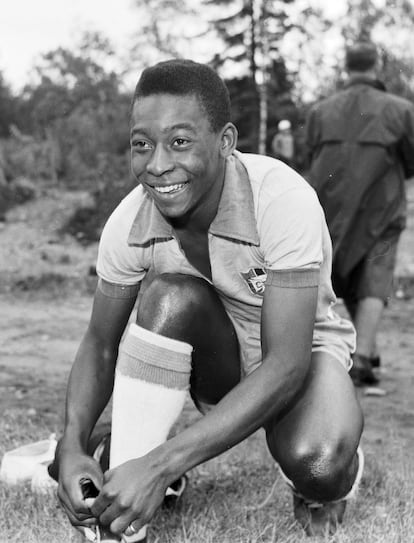The World Cup that Pelé didn’t want
In the lead-up to the 1970 World Cup in Mexico, the Brazilian military dictatorship did everything in its power to get its star player to participate

On November 19, 1969, in the Maracanã Stadium in Rio de Janeiro, Pelé readied himself for a penalty kick. “My legs were shaking,” he recalled, in a documentary about his life. Alone and terrified, he thought to himself: “I can’t miss this.”
That November night, Vasco de Gama’s goalkeeper readied himself for the shot from Santos’s star forward. He guessed correctly… but he didn’t reach the ball. Pelé slipped it in, before the eyes of 100,000 fans. Many stormed the field in celebration after he had made another piece of soccer history – he had scored his 1,000th goal. The fear was his alone – but the joy belonged to everyone.
Three days later, the then-dictator of Brazil, General Emílio Garrastazu Médici, asked to meet Pelé. The King obliged, immediately flying to the capital, Brasilia.
Médici, who had only been in power for a few weeks, understood the power of images. By linking himself to a star – and to the game of soccer – he could attach himself to what was beloved in Brazil.
Pelé, meanwhile, tried to treat all political issues with caution. “I’ve always kept the doors open… everyone knows this. Even in the worst moments.” Many disagreed with this attitude.
“People always want me to take sides,” he noted.
Pelé's supporters have always maintained that the risks of dissidence were not the same in a democracy as under a dictatorship. Pelé also defended himself in the 2021 documentary: “I don’t think I could have done anything else. I am Brazilian and I only want the best for Brazil… I am totally convinced that I have done much more for Brazil with my football – with my way of living – than many politicians who get paid to do that.”

In 1968, the dictatorship further entrenched itself by dissolving Congress. President Artur da Costa e Silva concentrated power in his hands – many rights and freedoms were suspended. A policy of censorship was established, while arbitrary arrests and torture became tools to stamp out political dissidence.
In this climate of institutional terror, General Médici – Costa e Silva’s successor – was regularly seen on Sundays in the box of the Maracanã Stadium. Since people loved soccer, the new dictator was able to use the sport to distance himself from the dirty acts going on behind the scenes. Being photographed with Pelé after his 1,000th goal helped him bolster his image as an ordinary, sports-loving fellow.
The next objective of the Brazilian dictatorship was the 1970 World Cup, to be held in Mexico. But after the bitter defeat that Brazil had suffered in England four years earlier, when Pelé was brutally kicked out of games, he had announced that he wouldn’t be going back to another international tournament: “I have no intention of playing in the World Cup anymore… I never have any luck,” he joked upon returning to Brazil in 1966. He had previously won the World Cup in 1958 and 1962.
But Médici needed Pelé. He sent the soccer star many emissaries – including high-ranking soldiers and ministers – attempting to change his mind. The footballer lived in constant anguish. “The World Cup was important for the country. But at that moment, I didn’t want to be Pelé.”
Political tensions did not affect only Pelé. When Médici took power, João Saldanha – a sports journalist and soccer coach – took over the Brazil national team. A member of the banned Communist Party, he was constantly harassed by the regime. In 1969, one of his old friends, Carlos Marighella, was assassinated by government agents, provoking his fury.
When he flew to Mexico in January 1970 to participate in the draw for the World Cup finals, Saldanha distributed a dossier to the international authorities. It included the names of 3,000 political prisoners, as well as hundreds of Brazilians who had been tortured or murdered by the regime. As punishment, Saldanha would be sacked just a few months before the tournament began.
Mario Zagallo – Saldanha’s replacement – was assisted by Army Captain Claudio Coutinho, who gave him unlimited resources to put Brazil back on course to win the World Cup. The national team’s success had become a pet project of the military – although it was viewed with suspicion by opponents of the regime and large segments of the independent press.
Many believed that a victory in Mexico would strengthen Médici, who had his country enter the tournament with a polarizing, ultranationalist slogan: “Brazil: love it or leave it.”
In the end, Pelé – under intense pressure from his teammates, fans and the governmental apparatus – decided to play. And he led his team to victory, thrashing Italy 4-1 in the final. But the fear of a Médici World Cup never materialized. It was, quite simply, the Pelé World Cup.
“Winning the 1970 World Cup was the best moment of my life… but it was more important for the country. If Brazil lost in 1970, it could have made everything worse. Being champions gave the country a breather,” he reflected.
“The best thing about victory is not the trophy. It’s the relief!”
Sign up for our weekly newsletter to get more English-language news coverage from EL PAÍS USA Edition
Tu suscripción se está usando en otro dispositivo
¿Quieres añadir otro usuario a tu suscripción?
Si continúas leyendo en este dispositivo, no se podrá leer en el otro.
FlechaTu suscripción se está usando en otro dispositivo y solo puedes acceder a EL PAÍS desde un dispositivo a la vez.
Si quieres compartir tu cuenta, cambia tu suscripción a la modalidad Premium, así podrás añadir otro usuario. Cada uno accederá con su propia cuenta de email, lo que os permitirá personalizar vuestra experiencia en EL PAÍS.
¿Tienes una suscripción de empresa? Accede aquí para contratar más cuentas.
En el caso de no saber quién está usando tu cuenta, te recomendamos cambiar tu contraseña aquí.
Si decides continuar compartiendo tu cuenta, este mensaje se mostrará en tu dispositivo y en el de la otra persona que está usando tu cuenta de forma indefinida, afectando a tu experiencia de lectura. Puedes consultar aquí los términos y condiciones de la suscripción digital.
More information
Archived In
Últimas noticias
Trump followed CIA recommendation to hand power to Delcy Rodríguez due to risk that Machado would not control the army
The Motherwell painting that Franco wanted to hide from view
Mexico seeks to shore up its defenses following US incursion in Venezuela
Hope gives way to uncertainty among Venezuelan exiles in the US after Maduro’s capture
Most viewed
- Alain Aspect, Nobel laureate in physics: ‘Einstein was so smart that he would have had to recognize quantum entanglement’
- Alvin Hellerstein, a 92-year-old judge appointed by Bill Clinton, to preside over Maduro’s trial in New York
- Cuba confirms death of 32 of its citizens in the US attack against Venezuela
- Gilles Lipovetsky: ‘If you want to live better and fall in love, take Prozac, don’t look to philosophy’
- Why oil has been at the center of Venezuela-US conflicts for decades











































